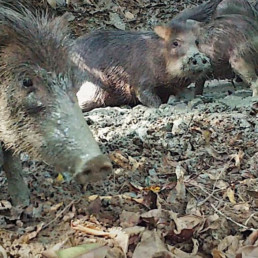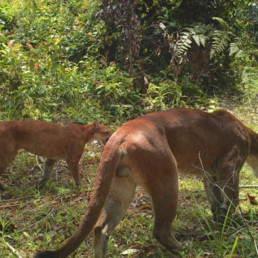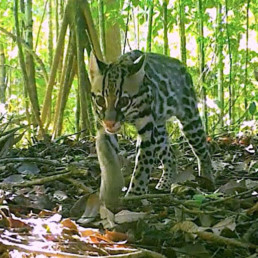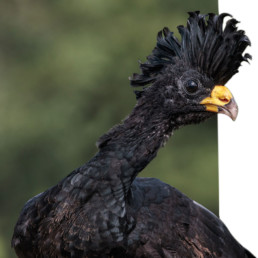Location
Osa Peninsula, southwest Costa Rica
Goal
To increase ecosystem resilience by restoring apex predator and prey populations and habitat connectivity in the Osa Peninsula.
Project Field Partner
Osa Conservation (OC) is leading a conservation effort that mobilizes citizen scientists, community members, ecotourism operators, park administrators and multiple NGOs to preserve the globally significant biodiversity of the Osa Peninsula in the face of climate change. To accomplish this, connectivity must be re-established from the Osa lowland rainforests to the Talamanca Mountains.
Size of Area Involved
109,300 hectares (1,093 km²)
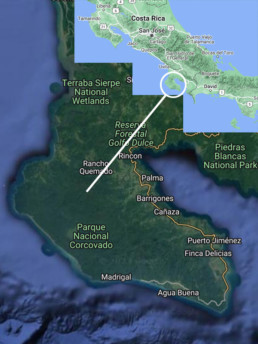
Maps data © 2024 Google
A biodiversity hotspot
The Osa Peninsula contains the largest mesic rainforest remaining on the Pacific slope of Central America, largely within Corcovado National Park. It has the largest expanse of mangrove wetlands on the Pacific slope of Central America and a unique coastal marine ecosystem—the Golfo Dulce tropical fjord. The Osa is estimated to house 2.5% of the world’s biodiversity while covering less than 0.001% of its total surface area, and was described by National Geographic in 2016 as “the most biological intense place on earth”.
Threats
The main threat in the Osa Peninsula is illegal hunting, which is still prevalent in the region. The concern is greatest with respect to the Lowland Paca (Cuniculus paca), White-lipped Peccary (Tayassu pecari) and Collared Peccary (Pecari tajacu). Other species are hunted to a lesser degree, including game birds such as: Tinamou (Tinamus major and Tinamus major castaneiceps) and Great Curassow (Crax rubra). Research has identified key areas of hunting pressure, however no concerted effort had been been made to reduce illegal hunting on the peninsula. A presentation at the 21st Mesoamerican Congress in San Jose in 2017 revealed that bushmeat offtake could be around 28.5 kg per year for each family hunting in the peninsula.
Rainforest Heroes of the Osa Peninsula, Costa Rica: Tomas Ridings Muñoz
In collaboration with a network of partners and local stakeholders, OC is rebuilding this connectivity via its ‘Ridge to Reef’ initiative to help protect one of the world’s last wild places. In 2022 OC planted 40,000 mangrove trees to restore 40 ha of degraded mangrove forest in the Térraba Sierpe wetlands—the largest protected wetland in Central America. It also planted 81,062 rare, native, and threatened trees species, to connect landscapes so biodiversity can thrive. OC trained 30 volunteer rangers to patrol 69,731 km of forest which generated 27,265 field biodiversity observations. This data was integrated in real time into the first Earth Ranger project in Latin America. It also protected and released 28,272 sea turtle hatchlings—for a total of 208,700 hatchlings released by OC—and collected 1,135 lbs. of garbage from pristine sea turtle nesting beaches with the help of 215 volunteers. To build capacity at the local level and to empower civil responsibility, OC employed 114 local community members through restoration, research, and conservation initiatives, and hosted over 400 community members at the bi-annual Rainforest Heroes Celebration. After its successful inaugural year (2021), OC’s ‘Ridge to Reef Nature Club’ continued to provide rural youth with an immersive nature-based learning model and to raise the next generation of conservation stewards. The Club grew to 9 chapters and engaged 2,521 youth across the Osa region in 2022.
Representation of locations where camera traps, acoustic devices, and soil & dung beetles samples were taken. At all the sites camera traps were set. In a subset acoustics coincide with camera trap locations (red diamond overlapped with black dot), another subset camera trap coincide with dung beetles and soil samples (red diamond overlapped with yellow dot), another subset three data collections were conducted, camera trap, acoustic, dung beetles and soils (red diamond overlapped with yellow and black dots). The communities where social surveys were conducted are named in the map (18 in total).

